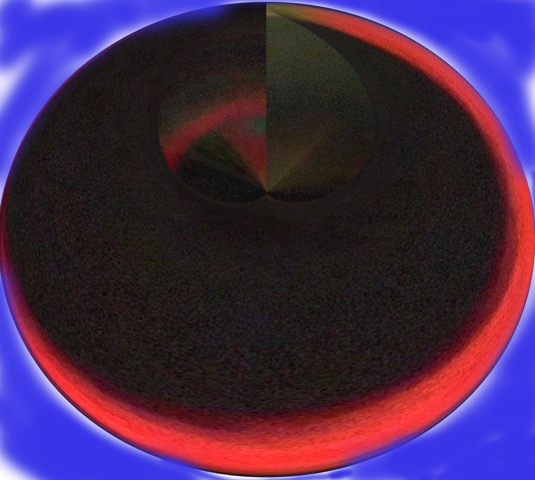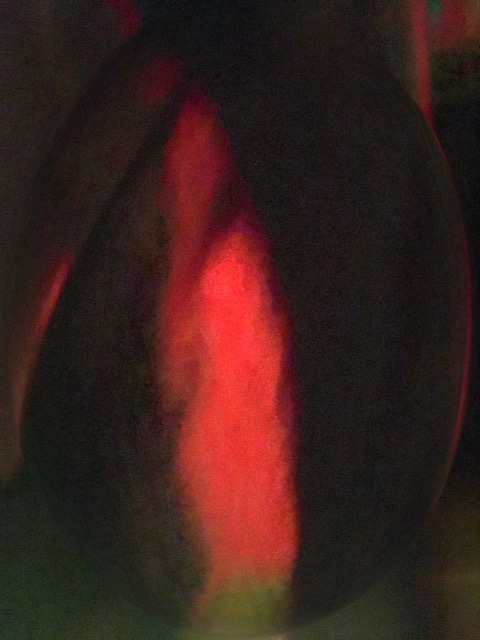Silence (44) - Mai Văn Phấn. Explication par Dr. Ramesh Chandra Mukhopadhyaya. Traduction française Dominique de Miscault
Explication par Dr. Ramesh Chandra Mukhopadhyaya
Traduction française Dominique de Miscault

Tác phẩm của Nhà thơ - Họa sỹ Dominique de Miscault chọn cho bài thứ 44
Silence
44
Au sommet de la colline
Je vois à l'intérieur de la terre
Un œil rouge feu
regarde le ciel
La terre
œil
rouge feu
flotte au loin ...
flotte…
Explication
À moins de grimper sur des hauteurs, on ne peut pas voir le fond des vallées. À moins d'aller sur les hauteurs de l'Empyrée, on ne peut pas avoir une vision globale de la terre. L'œil de Mai Văn Phấn voit au-delà de la surface des choses et de la surface de la terre : Le fer et le nickel - ou le magma brulant dans les entrailles de la terre. Qu’est que ce feu ? John Bunyan dans Le Voyage du pèlerin observait que la vie dans le monde est un feu. Le Grand Bouddha a découvert le feu du tanha ou la soif brûle la terre et l'existence. Le poète observe la terre depuis la hauteur de l’Empyrée. Et voilà ! La terre est comme un œil assoiffé qui avale tout. C'est une image bien connue : La terre ressemblant à un œil assoiffé peut nous rappeler une image surréaliste où deux images sont discrètement associées. Pensons aux horloges de Dali qui ressemblent à des organismes vivants. Mais des hauteurs de l'Empyrée, Mai Văn Phấn voit :
La terre
œil
rouge feu
flotte au loin ...
flotte…
Aucun poème n'a jamais pu décrire comment les désirs du monde et tanha ont pu être transcendée par une âme poétique qui est allée au-delà du royaume du désir brûlant. Ce poème appartient à la bouddhologie.
Le voyage du pèlerin est une allégorie chrétienne de 1678 écrite par John Bunyan. Il est considéré comme l'un des ouvrages les plus significatifs de la littérature religieuse anglaise.
Taṇhā signifie : soif, avidité, désir, convoitise. C'est, selon la deuxième noble vérité, l'origine de dukkha. Il s'agit de la fièvre de la convoitise insatiable, par opposition à la paix de l’esprit. La soif est précisément le désir de posséder encore et encore. Taṇhā recouvre les désirs brûlants (concupiscence, convoitise), « mais également le prurit spéculatif de l’insatiable mental qui fomente les apories métaphysiques ». La soif s'empare de l'objet, l'assume et s'y attache. Lui succède donc l'attachement ou appropriation. La soif est associée au plaisir à l'attachement et à l'habitude récurrente. Cette soif est soif de plaisir, d'existence, d'inexistence, mais également soif à l'égard des mondes de la forme, du sans forme (les extases), ainsi que le désir de l'arrêt du devenir. Taṇhā est l'un des Trois Poisons. C'est également un chaînon de la coproduction conditionnée. Cette soif est conditionnée par la sensation, verdana, et conditionne à son tour l'attachement, upana. Des synonymes de taṇhā sont raga, lobha et abhijjhā.
Silence (44) by Mai Văn Phấn
Explicated by Dr. Ramesh Chandra Mukhopadhyaya
Translated into French by Dominique de Miscault
Translated into Vietnamese by Takya Đỗ

Tác phẩm của Nhà thơ - Họa sỹ Dominique de Miscault chọn cho bài thứ 44
Silence
44
On top of the hill
I see inside the ground
A flaming red eye
Looking at the sky
The earth
In the shape of an eye
Flaming red
Floating away…
Floating…
(Translated from Vietnamese by Nhat-Lang Le & Susan Blanshard)
Explication
Unless you climb the hills you cannot see the valleys. Unless you go to the empyrean heights you cannot see the earth steadily and as a whole. The metaphysical eye of the poet Mai Văn Phấn can see beyond the surface of things and beyond the surface of earth. Iron and nickel – or the magma matter burns in the entrails of the earth. What could be the fire? Bunyan in his Pilgrim’s progress observed that the worldly life is afire. The Great Buddha discovered the fire of tanha or thirst burning the earth and the existence. The poet has been observing the earth from the empyrean height. And lo! The earth is as it were an eye aburning with thirst. It is an imagery which is time and again. The earth that looks like an eye aburning with thirst might remind us of the surrealist imagery where two discrete imagery are welded together. Think of Dali’s wristwatches looking like living organisms. But planted on the spiritual heights of the empyrean, Mai Văn Phấn finds:
Flaming red
Floating away…
Floating…
No poem has been ever able to describe how worldly desires and tanha flee from a poetic soul who has excelsiored from the realm of aburning desires. The poem is a hallmark in the realm of Buddhalogy.
Tĩnh lặng (44) của Mai Văn Phấn
Ramesh Chandra Mukhopadhyaya bình chú
Dominique de Miscault dịch sang tiếng Pháp
Takya Đỗ dịch sang tiếng Việt
44
Từ đỉnh đồi
Thấy trong đất
Một con mắt đỏ rực
Nhìn trời
Trái đất
Hình con mắt
Đỏ rực
Trôi đi...
Trôi...
Bình chú:
Nếu ta không trèo lên đỉnh đồi ta chẳng thể nào thấy được thung lũng. Nếu ta không lên đến đỉnh trời ta chẳng thể dần dần thấy được toàn cảnh trái đất. Con mắt siêu hình của nhà thơ Mai Văn Phấn có thể nhìn vượt khỏi bề mặt của vật và vượt khỏi bề mặt của trái đất. Sắt và ni-ken – hoặc nham thạch cháy trong lòng đất. Ngọn lửa có thể là gì nhỉ? Bunyan trong cuốn The Pilgrim’s Progress của mình cho rằng cuộc sống nơi trần thế là lửa cháy. Đức Phật thấy rằng ngọn lửa tham ái [tanha] hay ham muốn đang thiêu đốt trái đất và hiện tồn. Nhà thơ đang quan sát mặt đất từ đỉnh trời. Và kìa! Có thể nói mặt đất là một con mắt đang cháy đỏ vì tham ái.
Hình ảnh ấy lặp lại. Mặt đất trông như một con mắt đỏ rực vì ham muốn thèm khát gợi cho ta nhớ đến hình ảnh siêu thực mà trong đó hai hình ảnh riêng rẽ quyện vào nhau. Hãy xem những chiếc đồng hồ của Dali trông như những sinh vật sống. Nhưng đứng ở đỉnh tâm linh trên chín tầng không, Mai Văn Phấn thấy:
Đỏ rực
Trôi đi...
Trôi...
Chưa bài thơ nào từng mô tả được cái cách những ham muốn trần tục hay lòng tham ái thoát ra khỏi một tâm hồn thi sĩ ra sao, cái tâm hồn đã vươn lên từ địa hạt những ham muốn cháy đỏ ấy. Bài thơ này là một dấu ấn trong lĩnh vực Phật học.

Ts. Ramesh Chandra Mukhopadhyaya
Dr. Ramesh Chandra Mukhopadhyaya
Address: 6/ 1 Amrita Lal Nath lane P.0. Belur Math Dist Howrah West Bengal India Pin code711202. Date of Birth 11 02 1947. Education M.A [ triple] M Phil Ph D Sutrapitaka tirtha plus degree in homeopathy. He remains a retired teacher of B.B. College, Asansol, India. He has published books in different academic fields including religion, sociology, literature, economics, politics and so on. Most of his books have been written in vernacular i.e. Bengali. Was awarded gold medal by the University of Calcutta for studies in modern Bengali drama.
TS. Ramesh Chandra Mukhopadhyaya
Địa chỉ: 6/ 1 đường Amrita Lal Nath hòm thư Belur Math Dist Howrah Tây Bengal Ấn Độ mã số 711202. Ngày sinh: 11 02 1947. Thạc sĩ văn chương, thạc sĩ triết học, tiến sĩ triết học [bộ ba] cùng với Bằng y học về phép chữa vi lượng đồng cân. Ông còn là một giảng viên đã nghỉ hưu của Trường đại học B.B, Asansol, Ấn Độ. Ông đã có những cuốn sách được xuất bản về nhiều lĩnh vực học thuật bao gồm tôn giáo, xã hội học, văn học, kinh tế, chính trị v.v. Hầu hết sách của ông đã được viết bằng tiếng bản địa là tiếng Bengal. Ông đã được tặng thưởng huy chương vàng của Trường đại học Calcutta về các nghiên cứu nghệ thuật sân khấu Bengal hiện đại.

Nhà thơ - Nghệ sỹ Dominique de Miscault
Poétesse - Artiste Dominique de Miscault
Artiste Plasticienne. Actualités. De plages en pages qui se tournent. C’était hier, de 1967 à 1980, mais aussi avant hier. puis de 1981 à 1992. Et encore de 1992 à 2012 bien au delà des frontières. Aujourd’hui, la plage est blanche sous le bleu du soleil. Ecrire en images, cacher les mots porteurs de souffrance ; on ne raconte pas les pas d’une vie qui commence en 1947. C’est en 1969 que j’ai été invitée à exposer pour la première fois. Depuis j’ai eu l’occasion de « vagabonder » seule ou en groupe en France et dans le monde sûrement près de 300 fois. Les matériaux légers sont mes supports, ceux du voyage et de l’oubli.
www.dominiquedemiscault.fr
www.dominiquedemiscault.com
www.aleksander-lobanov.com
Nhà thơ - Nghệ sỹ Dominique de Miscault
Nghệ sĩ nghệ thuật thị giác đương đại. Từ bãi biển đến trang giấy. Là ngày hôm qua, từ 1967 đến 1980, và trước đó, rồi từ 1981 đến 1992. Và nữa từ 1992 đến 2012 trên tất cả các biên giới. Ngày hôm nay là bãi biển trắng dưới bầu trời xanh. Viết bằng hình ảnh, giấu từ ngữ mang nỗi đau, người ta không kể lại những bước đi trong cuộc đời tính từ năm 1947. Vào năm 1969, lần đầu tiên tôi được mời triển lãm tác phẩm. Kể từ đó, tôi có cơ hội một mình "lang bạt" hoặc theo nhóm ở nước Pháp và khắp nơi trên thế giới, chắc chắn gần 300 lần. Những chất liệu nhẹ là nguồn hỗ trợ tôi, những chất liệu của hành trình và quên lãng.
www.dominiquedemiscault.fr
www.dominiquedemiscault.com
www.aleksander-lobanov.com
Tĩnh lặng - Silence (1)
Tĩnh lặng - Silence (2)
Tĩnh lặng - Silence (3)
Tĩnh lặng - Silence (4)
Tĩnh lặng - Silence (5)
Tĩnh lặng - Silence (6)
Tĩnh lặng - Silence (7)
Tĩnh lặng - Silence (8)
Tĩnh lặng - Silence (9)
Tĩnh lặng - Silence (10)
Tĩnh lặng - Silence (11)
Tĩnh lặng - Silence (12)
Tĩnh lặng - Silence (13)
Tĩnh lặng - Silence (14)
Tĩnh lặng - Silence (15)
Tĩnh lặng - Silence (16)
Tĩnh lặng - Silence (17)
Tĩnh lặng - Silence (18)
Tĩnh lặng - Silence (19)
Tĩnh lặng - Silence (20)
Tĩnh lặng - Silence (21)
Tĩnh lặng - Silence (22)
Tĩnh lặng - Silence (23)
Tĩnh lặng - Silence (24)
Tĩnh lặng - Silence (25)
Tĩnh lặng - Silence (26)
Tĩnh lặng - Silence (27)
Tĩnh lặng - Silence (28)
Tĩnh lặng - Silence (29)
Tĩnh lặng - Silence (30)
Tĩnh lặng - Silence (31)
Tĩnh lặng - Silence (32)
Tĩnh lặng - Silence (33)
Tĩnh lặng - Silence (34)
Tĩnh lặng - Silence (35)
Tĩnh lặng - Silence (36)
Tĩnh lặng - Silence (37)
Tĩnh lặng - Silence (38)
Tĩnh lặng - Silence (39)
Tĩnh lặng - Silence (40)
Tĩnh lặng - Silence (41)
Tĩnh lặng - Silence (42)
Tĩnh lặng - Silence (43)

Tác phẩm của Nhà thơ - Họa sỹ Dominique de Miscault chọn cho bài thứ 44